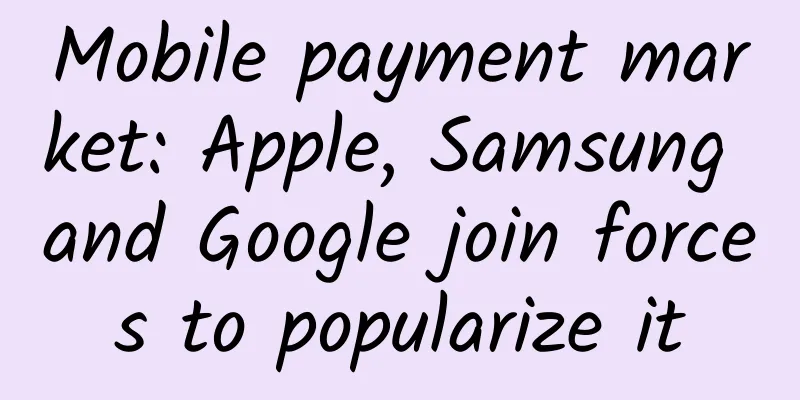Mobile payment market: Apple, Samsung and Google join forces to popularize it

|
Just after the Spring Festival of the Year of the Monkey, Apple and Samsung, the world's two largest smartphone giants, launched their own mobile payment services in the Chinese market, officially entering China's rapidly growing mobile payment market. Apple Pay was officially launched on February 18, and Samsung Pay began public testing on February 24 and was officially released this month. Thanks to Apple's strong brand appeal and huge user base, Apple Pay has attracted media attention since its first day of release, prompting millions of Apple fans to try out the service and show it on social networks. Data from Internet Retailer, a third-party market research firm, showed that 3 million UnionPay cards were bound to Apple Pay in China within two days of its launch; this data was also confirmed by China Merchants Bank, of which 1 million cards came from China Merchants Bank. This speed is significantly higher than that of the US market. In October 2014, Apple Pay attracted more than 1 million bank card bindings within three days of its launch in the US market. However, one thing that cannot be ignored is that at that time, only the newly released iPhone 6 and iPhone 6 Plus, which were in the rush to buy, could use mobile payment; while when Apple Pay was launched in the Chinese market, there were at least tens of millions of users who could use this service. While the Chinese market has just started, Apple and Samsung are also working together to popularize mobile payment in the US and even the global market. Working together with them to change the usage habits of American consumers is another giant that has regrouped - Google. Apple Pay was first launched in the US in October 2014. Samsung Pay was first launched in South Korea in August 2015 and landed in the US market the following month. Android Pay was officially launched in the US in September last year. The US market is the most important step in the popularization of the three major mobile payment solutions. Although Apple Pay was released a year earlier than Samsung and Google Pay, in the US where credit card payment habits are deeply rooted, the mobile wallet payments of these three giants are still in the early stages of pioneering and promotion. A report released by market research firm Juniper Research predicts that 148 million consumers around the world will use contactless payment methods this year, and mobile wallets will become the main driving force for growth. Among new users of contactless payment methods, about 70% are Apple and Samsung Pay consumers, which is obviously related to the huge user base of Apple and Samsung. In the US smartphone market, Apple and Samsung have an absolute market advantage, with market shares of 42.9% and 28.4% respectively (comScore data as of the end of last year). In addition, at the operating system level, Android has a dominant share of 53.3%. This means that Google, Apple and Samsung have tens of millions of potential smartphone payment users in the United States. Because the user groups they target do not overlap, Apple and Samsung Pay do not have a zero-sum competition, but rather an unintentional partnership to jointly change user habits. However, there is a high degree of overlap between Google's Android Pay and Samsung Pay, and users of Samsung's high-end phones can use both payment methods at the same time. Market research firm Crone Consulting predicted this week that while Apple Pay remains the leader in mobile payments, the user bases of Android Pay and Samsung Pay are growing rapidly. Data released by Samsung at the end of last month showed that since the launch of Samsung Pay in September last year, its user base has exceeded 5 million, with transaction volume reaching US$500 million. Google's Android Pay, which was also launched in September last year, currently has 5 million monthly active users. In contrast, Apple Pay, which was launched a year earlier, has 12 million users. The report therefore believes that although Apple Pay currently has an advantage in user base, Samsung Pay and Android Pay seem to be growing faster. However, this conclusion seems somewhat controversial. When new services of giants such as Apple and Google are launched, they can easily attract a large number of users' attention and use, making a good start. However, this bonus during the launch period does not mean that the same growth rate can be maintained in the future. Proportion of available models for the three major mobile payment methods In terms of user scale, Apple Pay is mainly applicable to a total of four models after the iPhone 6 in 2014 (iPhone 6, 6 Plus, 6s, 6s Plus), and Samsung Pay is mainly applicable to the 2015 Galaxy S6, S6 Edge, S6 Edge+, Note 5 and the upcoming S7 series. (The Samsung Pay function cannot be used on the S6 and S6 Edge in the Chinese market). On the other hand, Android Pay is mainly applicable to models with Android 4.4 or later and support NFC. In theory, nearly half of Android phones can use this service, except for the Chinese market. On Samsung models released after 2015, users can choose Samsung Pay or Android Pay, and there is user overlap between the two services. Compared with Apple Pay, Samsung Pay can be used not only through NFC chip card machines, but also through traditional magnetic stripe chip terminals. This is the biggest advantage of Samsung's payment solution. According to data released by market research company Crone, in the US market, only 15% of POS terminals support Apple Pay, while 85% of terminals support Samsung Pay. The expansion space for the three major mobile payment solution providers also includes the huge global market. Market research company Forrester predicts that the global mobile payment market will reach US$142 billion in 2019. In the global market, Samsung and Apple's market share in 2015 were 24.8% and 17.5% respectively, which is a huge advantage over Huawei (8.4%), which ranks third (TrendForce statistics). Currently, Apple Pay has or will soon be expanded to markets such as the United States, the United Kingdom, Canada, Australia, China, Hong Kong, Singapore and Spain. Samsung Pay markets include or will soon include South Korea, the United States, China, the United Kingdom, Australia, Brazil, Singapore, Spain, Canada and other markets. Android Pay is currently applicable to the US market and plans to expand to overseas markets such as the United Kingdom and Australia this year. Among them, Apple and Samsung will vigorously promote in the Chinese market. |
<<: Health Science | The Correct Way to "Starve" Tumors to Death
>>: Recognize these three acupoints to easily relieve nasal congestion symptoms!
Recommend
Case of 8-month pregnancy after cesarean section
In daily life, we will encounter some mothers who...
Can uterine nodules disappear?
Every organ of the human body is of great signifi...
What is the best time for gynecological B-ultrasound?
With the continuous improvement of living standar...
Urinary tract infection after one day of intercourse
Urinary tract infection can occur at any age, bot...
Why do I feel particularly hungry during my period?
When menstruating, everyone's performance wil...
When is the best time for women to lose weight?
When is the best time for women to lose weight? S...
Will women with kidney deficiency urinate frequently?
Many people know that men are prone to kidney def...
Bright red lochia half month after delivery
Pregnant women will all discharge lochia after gi...
Symptoms of pain on both sides of the lower abdomen in women
In fact, in life, some female friends do not take...
What's wrong with not having clean period for half a month?
If the menstrual period is not clean for more tha...
Is it possible to be pregnant if my nipples hurt during ovulation?
There are nipples on the breasts, which is a huma...
Why do I have back pain before my period?
If a woman experiences lower back pain before her...
Is it important to have sex before a gynecological examination?
In order to ensure their own physical and mental ...
What are the symptoms of Qi stagnation and blood stasis in women?
Qi and blood problems have always been an importa...









